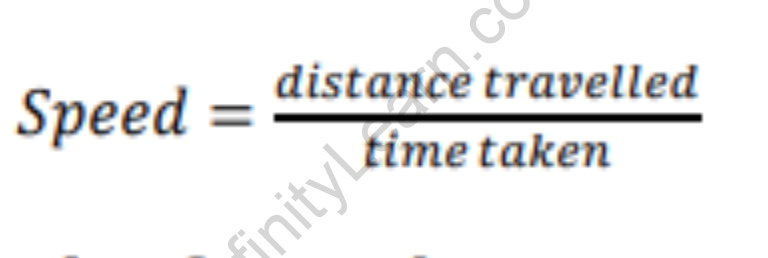Table of Contents
What is Speed?
The distance covered by an object in a unit of time is defined as the Speed of the object. It is the ratio of the total distance covered by an object and the time taken by it to cover that distance.
- Formula of speed:

- Unit of speed
Meters per second is one of the units of speed.
There are other such units of speed, for example, kilometers per hour, miles per hour, feet per minute, and so on.
Let us look at an example. If a car travels a distance of 420 meters in 30 seconds, then its speed is given as below:
What is Constant speed?
When the speed of an object remains the same, that is, it does not increase or decrease, it is said to be moving at a Constant speed. It means that the speed of the object at any point in time is constant.
For example, if an object is moving at a constant speed of 10 meters per second along a straight-line path, at any point on the path its speed will be equal to 10 meters per second. It also implies that the object will cover equal distances in equal intervals of time.
What is Average speed?
Average speed is defined as the total distance covered by an object over the total time taken. Let us understand this concept in detail with the help of an example If a car travelled a distance of 20 km in 4 hours, its speed will be 5 km/hr. But this does not mean that the car traveled at a constant speed of 5 km every hour. The car could have started slowly initially and then picked up speed. This means the speed of the car is not uniform all through the distance traveled. So in other words, the speed 5 km/hr is the average speed of the car.
What is Instantaneous speed?
Instantaneous speed is the speed of an object at a particular moment in time. For example, when the indicator of a car reads 30 kilometers per hour it means that at that moment in time, the car is traveling at 30 kilometers per hour. It does not mean that the car has been traveling at this speed or will travel at this speed. The value is only at that instant. And that is why the pointer is never really constant in the speedometer. It keeps fluctuating.
Solved Examples on Distance Speed Time Formula
Example 1: A car travels a distance of 300 kilometers in 5 hours. What is its speed?
Solution:
Given:
Distance = 300 kilometers
Time = 5 hours
Speed is calculated by dividing the distance traveled by the time taken.
Speed = Distance / Time
Speed = 300 km / 5 h
Speed = 60 km/h
Therefore, the speed of the car is 60 kilometers per hour.
Example 2: A cyclist completes a 40-kilometer journey in 2 hours and 30 minutes. What is their speed?
Solution:
Given:
Distance = 40 kilometers
Time = 2 hours and 30 minutes
First, we need to convert the time to hours.
Time (in hours) = 2 hours + 30 minutes / 60 (conversion from minutes to hours)
Time (in hours) = 2.5 hours
Speed = Distance / Time
Speed = 40 km / 2.5 h
Speed = 16 km/h
Therefore, the speed of the cyclist is 16 kilometers per hour.
Frequently asked questions on Distance Speed Time Formula
What is the relationship between distance, speed, and time?
The relationship between distance, speed, and time is given by the formula: Distance = Speed × Time. This formula shows that distance is equal to the product of speed and time.
What is speed?
Speed is a measure of how fast an object is moving. It is defined as the distance traveled per unit of time. Speed is a scalar quantity and is typically measured in units such as kilometers per hour (km/h) or meters per second (m/s).
What is the formula for speed?
The formula for speed is: Speed = Distance / Time. This formula shows that speed is calculated by dividing the distance traveled by the time taken.
How can the concepts of distance, speed, and time be applied in real-life situations?
The concepts of distance, speed, and time are applied in various real-life situations, such as calculating travel times, determining average speeds of vehicles, estimating arrival times, planning transportation routes, and analyzing the efficiency of transportation systems.
What are the units commonly used to measure distance, speed, and time?
Distance is commonly measured in units such as kilometers (km) or miles (mi), speed is measured in units such as kilometers per hour (km/h) or miles per hour (mph), and time is measured in units such as hours (h) or minutes (min).
Can speed be negative?
No, speed is a scalar quantity and cannot be negative. It represents the magnitude of the velocity, which is a vector quantity that includes both magnitude (speed) and direction. However, the direction of motion can be represented by positive or negative values.
What is the difference between average speed and instantaneous speed?
Average speed is the total distance traveled divided by the total time taken, providing an overall measure of speed during a journey. Instantaneous speed, on the other hand, refers to the speed of an object at a particular instant in time. It represents the speed at a specific moment along the path of motion.









